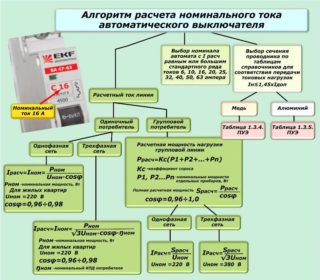Electricity, if used incorrectly, can pose a threat to the environment, health and human life. To exclude such cases, the rules for the use of electricity have been introduced (PUE, national and international standards), which oblige all power circuits to be supplied with protective devices. Among these elements are circuit breakers. To choose them correctly, you need to understand the characteristics that are reflected in the labeling.
General information about machines
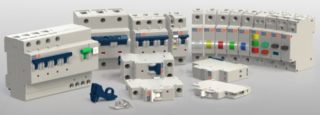
As a rule, the machine contains three types of electrical circuit release: thermal, electromagnetic and mechanical. The first is designed to protect electrical circuits from overcurrent, the second - from short circuit in load circuits, the third - for operational switching of electrical circuits.
There are electrical machines that perform protective functions against overload and electric shock (ET). These are circuit breakers controlled by differential current with built-in protection against current overloads - difavtomats (DV).
Main technical characteristics of circuit breakers (AB)
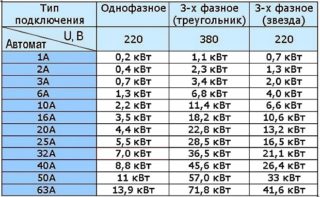
Rated voltage is the value set by the manufacturer at which the AV performance is determined.
Rated current - the current set by the manufacturer, which AB is capable of carrying out in a continuous mode, in which the main contacts remain closed at the specified control ambient temperature (standard +30 ° C).
The breaker frequency is the power frequency for which the device is designed and to which the values of other characteristics correspond.
The rated short-circuit breaking capacity is the value of ET, which can turn off the AB, while maintaining its operability.
The current limiting class is characterized by the tripping time between the start of opening of the circuit breaker and the end of the arc time. There are three classes of current limitation:
- the shutdown time of class 3 AB occurs within 2.5 - 6 ms;
- 2 classes - 6-10 ms;
- 1st class - more than 10 ms.
The protective characteristic AB determines the time limits during which the tripping of the switching element must occur at a certain value of the ET flowing through it.
There are several types of protective (time-current) characteristics of AB, the most demanded are B, C and D
| Protective characteristic type | Range of instantaneous tripping currents reduced to the rated value of the current AB | Appointment |
| A | from 1.3Iн | For the protection of circuits in which temporary overcurrent cannot occur during normal operation. |
| IN | from 3In to 5In | For protection of circuits in which insignificant temporary current overloads are allowed in normal operation. |
| FROM | from 5In to 10In | For the protection of circuits in which moderate temporary current overloads are allowed in normal operation. |
| D | from 10In to 20In | For the protection of circuits with significant temporary current overloads in normal operation. |
| K | from 12 Iн | For the protection of industrial circuits using inductive loads. |
| Z | from 4 Iн | For the protection of industrial circuits using industrial electronics as a load. |
Differential circuit breakers
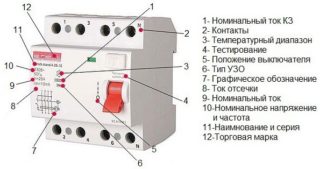
Rated breaking differential current I∆n is the value of the breaking differential current specified by the manufacturer, at which the DC must operate under the specified conditions.
Rated non-switching differential current I∆n0 is the value of non-switching differential current specified by the manufacturer, at which the DV does not operate under the specified conditions.
Rated differential most making and breaking capacity I∆m0 is the rms value of the alternating component of the expected differential current, which the DV can make, conduct and break.
DV are of three types:
- S - with differential current response time delay.
- AS - tripping is ensured with a sinusoidal alternating differential current, either applied by a step or slowly increasing.
- BUT - Provides tripping at differential sinusoidal alternating current and differential pulsating direct current applied by a step or slowly increasing.
Labeling machines
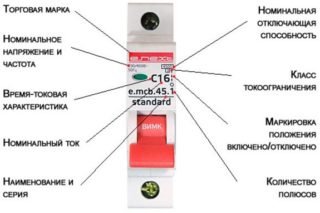
Each machine has its own markings, which are alphanumeric and conventional graphic images used to identify and bring to the consumer its main technical characteristics. They are necessary for the correct selection and further operation of the machine.
- manufacturer's name or trade mark;
- type designation, catalog number or series number;
- rated voltage value;
- the values of the rated current without the symbol "A" with the preceding designation of the type of protective characteristic (A, B, C, D, K, Z) and the class of current limitation;
- value of the nominal frequency;
- the value of the rated short-circuit breaking capacity in amperes;
- connection diagram if the correct connection method is not obvious;
- the value of the control temperature of the ambient air, if it differs from 30 ° С;
- degree of protection, if only it differs from IP20;
- for D-type circuit-breakers, the maximum instantaneous tripping current if it is higher than 20In;
- value of rated impulse withstand voltage Uimp.
The marking of difavtomats is similar to the AB marking, but contains additional information:
- rated breaking differential current;
- setting of the tripping differential current (for DV with several values of the tripping differential current);
- rated largest differential making and breaking capacity;
- a button with the "T" symbol for operational control of the DV operability by differential current;
- symbol "~" - for DV type AC;
- symbol for DV type A.
Explanation of designations of circuit breakers
Along with the marking of the switches, the necessary information about the characteristics and type of AB contains its symbol, which is required to place an order for the purchase of AB.
The circuit breaker symbol is as follows: VA47-X1-X2X3X4XX5-UHL3
Explanations for the symbol AB are given in the table.
| Symbol | Decoding |
| VA47 | Circuit breaker series designation |
| X1 | Switch type |
| X2 | Number of poles |
| X3 | The letter "N" in the presence of a pole without a release |
| X4 | Protective characteristic type |
| XX5 | Rated operational current |
| UHL3 | Designation of climatic modification and placement category (according to GOST 15150) |
Examples of writing AB designations:
- single-pole circuit breaker with a protective characteristic of the "C" type for a rated current of 16 A: Switch VA47-29-1S16-UHL3
- four-pole automatic circuit breaker with a protective characteristic of the "C" type with an unprotected pole for a rated current of 100 A: Switch VA47-100-4NC100-UHL3.
For products of UHL3 design, the operating temperature range is from minus 60 to +40 ° С.
Each machine, mounted in the switchboard, is marked in accordance with its functional purpose. For example, room number, designation of a feeder, equipment, etc.to protect the electrical circuits of which this machine is installed.
Tips for choosing a circuit breaker
The rated current AB is selected with a value less than or equal to the maximum current for which the protected electrical circuit is designed. If the electrical circuit is made with a copper wire with a conductor cross-section of 1.5 mm2, to protect such a circuit, AB with a rated current of not more than 16 A. short circuit duration of 1 s must be no more than 170 A, the protective characteristic AB can be selected C type. In this case, the class of current limitation can be any, however, it should be borne in mind that the earlier the electrical circuit is disconnected in case of a short circuit, the less the likelihood of an emergency situation and the more chances to keep the electrical equipment in good condition.
The number of poles AB is selected based on the number of protected electrical circuits. For a single-phase circuit, two-pole are usually used, for three-phase - three and four-pole AB.
Among foreign manufacturers, it should be noted: ABB, Legrand, Schneider Electric, General Electric, Siemens, etc. Among domestic manufacturers, one can single out the products of KEAZ, IEK, Kontaktor, etc. To solve budgetary problems, the products of a Russian company fully justify themselves. To implement business ideas, you can use more expensive and high-quality products of foreign manufacturers ABB, Legrand, Schneider Electric.
For practical reasons, it is advisable to build a protection system against current overloads according to a two-level scheme. The first level of protection is to be performed on the basis of VD. Since electricity consumers are usually distributed in separate rooms, it is advisable to perform the second stage of protection of a distributed type, grouping electrical circuits by functional purpose and supplying each group with a separate AB, which will avoid a general power outage in the event of a local current overload. In this case, the VD must be designed for the total current of all electricity consumers.

